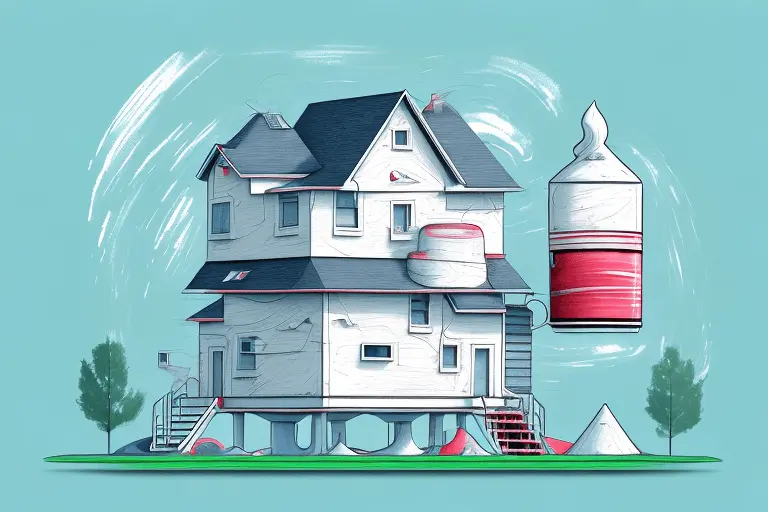Exterior house painting can be a challenging task, especially when it comes to dealing with heights and unpredictable weather conditions. But, how to paint outside your house without scaffolding? While scaffolding is commonly used to make the job easier, not everyone has access to it. Fortunately, there are ways to paint the exterior of your house without scaffolding. In this article, LEWIS Access discuss the challenges of scaffold-free painting, the necessary tools and equipment, preparing your house for painting, and techniques to achieve a professional finish.
Understanding the Challenges of Exterior House Painting
When it comes to painting the exterior of your house, there are several challenges that need to be addressed in order to achieve a successful outcome. While painting without scaffolding may seem like a cost-effective option, it is important to be aware of the potential difficulties that lie ahead.
Two significant challenges that you will encounter when painting at heights are the risks involved and the need to deal with varying weather conditions.
Risks of Painting at Heights
Painting at heights can be a daunting task, especially without the proper safety precautions in place. The potential for accidents and injuries is significantly higher when working at elevated positions. Falling from a ladder or attempting to balance on uneven surfaces can lead to severe consequences.
It is essential to assess the risks involved and take necessary precautions to ensure your safety. This includes using sturdy and reliable ladders or scaffolding, wearing appropriate safety gear such as helmets and harnesses, and having a spotter or helper to assist you during the painting process.
Additionally, it is important to be mindful of your surroundings and the potential hazards that may exist. Overhanging tree branches, power lines, or other obstructions can pose a threat and should be taken into consideration before starting the project.
Dealing with Weather Conditions
Another challenge that you will face when painting the exterior of your house is the unpredictable nature of weather conditions. Rain, wind, and extreme temperatures can all have a significant impact on the quality and longevity of the paint job.
Applying paint during rainy or humid weather can result in poor adhesion and an uneven finish. Similarly, strong winds can cause the paint to dry too quickly, leading to cracking and peeling. Extreme temperatures, whether hot or cold, can also affect the paint’s application and drying process.
Therefore, it is crucial to plan your painting project during a period of stable weather to achieve the best results. Monitor weather forecasts and choose a time when the conditions are expected to be dry, calm, and within the recommended temperature range for the paint product you are using.
Furthermore, it is advisable to prepare your house properly before painting to minimise the impact of weather conditions. This includes cleaning the surface thoroughly, repairing any damaged areas, and applying a suitable primer to enhance the paint’s durability.
By understanding and addressing these challenges, you can ensure a successful exterior house painting project that not only enhances the aesthetic appeal of your home but also provides long-lasting protection against the elements.
Necessary Tools and Equipment for Scaffold-Free Painting
Before you begin painting the exterior of your house without scaffolding, it is important to gather the necessary tools and equipment. The following are some essential items that will aid you in reaching high areas and achieving a professional finish.
When it comes to painting the exterior of your house, there are several factors to consider. The height of the building and the accessibility of certain areas can pose a challenge. However, with the right tools and equipment, you can overcome these obstacles and achieve great results.
Choosing the Right Ladder
Investing in a sturdy and reliable ladder is crucial for scaffold-free painting. Look for a ladder with adjustable height, non-slip feet, and a secure locking mechanism. A ladder with a platform or paint tray attachment can make the process more convenient.
When selecting a ladder, consider the height of your house and the specific areas you need to reach. A ladder with adjustable height will allow you to paint different sections without having to constantly reposition it. Non-slip feet are essential for stability, especially when working on uneven surfaces.
Furthermore, a ladder with a secure locking mechanism will ensure your safety while painting. It will prevent the ladder from collapsing or shifting unexpectedly, providing you with peace of mind as you work on your project.
At LEWIS Scaffold Towers, we have several ladders suitable for house painting: double extension ladders and triple extension ladders.
Extension Poles for Painting
Extension poles are versatile tools that allow you to reach high areas without the need for scaffolding. These poles can be attached to paint rollers or brushes, enabling you to paint large areas with ease. Choose an extension pole that is lightweight yet durable.
When using an extension pole, it is important to find the right balance between weight and durability. A lightweight pole will be easier to handle and manoeuvre, reducing fatigue during long painting sessions. On the other hand, a durable pole will ensure that it can withstand the pressure of applying paint to various surfaces.
Extension poles also provide you with greater control and precision. You can easily adjust the length of the pole to reach different heights, allowing you to paint even the most hard-to-reach areas. With the right extension pole, you can achieve a smooth and even finish on your exterior walls.
Safety Equipment for Ground-Level Painting
Even when painting at ground level, safety equipment is essential. Wear protective goggles, gloves, and a dust mask to shield yourself from potential harm. Additionally, use drop cloths or tarps to protect the surrounding surfaces from paint splatters.
While scaffold-free painting may not involve working at extreme heights, it is still important to prioritise safety. Protective goggles will shield your eyes from any paint splatters or debris that may be present. Gloves will protect your hands from chemicals and ensure a firm grip on your tools.
A dust mask is crucial for filtering out any harmful particles that may be released during the painting process. It will prevent you from inhaling dust or fumes, safeguarding your respiratory system. Lastly, using drop cloths or tarps will protect the ground and nearby objects from accidental paint spills or drips.
By wearing the appropriate safety equipment, you can minimise the risk of accidents and injuries while painting. It is always better to be safe than sorry, so make sure to prioritise your well-being throughout the entire process.
Preparing Your House for Painting
Proper preparation is key to achieving a successful paint job. Before you start painting, take the time to clean the exterior walls, repair any damages or cracks, and apply a suitable primer.
Painting the exterior of your house not only enhances its curb appeal but also protects it from the harsh elements. However, a beautiful and long-lasting paint job requires careful preparation. By following these steps, you can ensure that your house is ready for a fresh coat of paint.
Cleaning the Exterior Walls
Thoroughly clean the exterior walls to remove dirt, debris, and loose paint. Over time, dirt and grime can accumulate on the surface, making it difficult for the paint to adhere properly. To clean the walls, you can use a pressure washer or a mixture of water and mild detergent. Gently scrub the surface to wash away any stubborn stains or mould. Rinse the walls thoroughly and allow them to dry completely before proceeding.
As you clean the walls, take the opportunity to inspect for any signs of damage or wear. Look for areas where the paint has peeled or cracked, as these will need to be addressed before painting. By starting with a clean surface, you can ensure that the paint will adhere evenly and provide a smooth finish.
Repairing Damages and Cracks
Inspect the exterior walls for any damages or cracks. Over time, weather conditions and natural wear and tear can cause the walls to develop cracks or holes. It is important to address these issues before applying a new coat of paint.
Start by filling in the cracks with a suitable filler. There are various types of fillers available and the type depends on the size and depth of the crack. Apply the filler using a putty knife, ensuring that it is evenly distributed and smooth. Once the filler is dry, sand the surface to create a seamless finish.
In addition to repairing cracks, it is crucial to replace any rotten wood or damaged siding. These areas can compromise the structural integrity of your house and affect the overall appearance of the paint job. By replacing the damaged materials, you can ensure a solid foundation for the paint and prevent future issues.
Applying Primer
Applying a layer of primer before the paint helps to promote adhesion and improve the durability of the paint job. Primer acts as a barrier between the surface and the paint, ensuring that the colour adheres evenly and lasts longer.
When choosing a primer, consider the type of surface you are painting on. Different surfaces, such as wood, stucco, or metal, may require specific primers to achieve the best results. Consult with your local paint store or manufacturer’s instructions to select the appropriate primer for your project.
Before applying the primer, make sure the surface is clean and dry. Use a brush or roller to apply the primer in even strokes, following the manufacturer’s recommended drying time between coats. Primer not only enhances the colour of the paint but also helps to cover any imperfections on the surface, ensuring a smooth and flawless finish.
By taking the time to properly prepare your house for painting, you can ensure a professional-looking result that will last for years to come. Remember, preparation is the key to a successful paint job, so don’t rush through these important steps. Your efforts will be rewarded with a beautiful and long-lasting finish that will make your house the envy of the road.
Techniques for Scaffold-Free Painting
Once your house is adequately prepared, it’s time to start painting. Here are some techniques that will help you achieve a seamless and professional finish without the need for scaffolding.
Painting from Top to Bottom
Start by painting the highest areas first, such as the peaks of the roof or chimneys. This will help you maintain a consistent paint flow and avoid any drips or streaks on areas you have already painted. Gradually work your way down to the lower sections of the house.
Using a Roller or Brush
Decide whether to use a roller or a brush based on the type of surface you are painting and your personal preference. Rollers are ideal for large, smooth areas, while brushes are better suited for detailed work and rough surfaces. Use even and overlapping strokes to ensure an even application of paint.
Dealing with Hard-to-Reach Areas
For areas that are difficult to reach with a ladder or extension pole, consider using a paint sprayer. A paint sprayer can help you cover intricate details or tight corners more efficiently. Take necessary precautions to protect nearby surfaces from overspray.
With these techniques and tools, you can paint the exterior of your house without the need for scaffolding. Remember to prioritise safety, properly prepare the surfaces, and use quality paint for long-lasting results. By taking the time to plan and execute your paint job carefully, you can achieve a beautifully painted house that enhances its curb appeal.
If you’d prefer to paint your house with scaffold towers, then it’s worth reading: How do I paint my house with scaffold towers? And, it could be worth reading about the pros & cons to hiring scaffold towers too.


